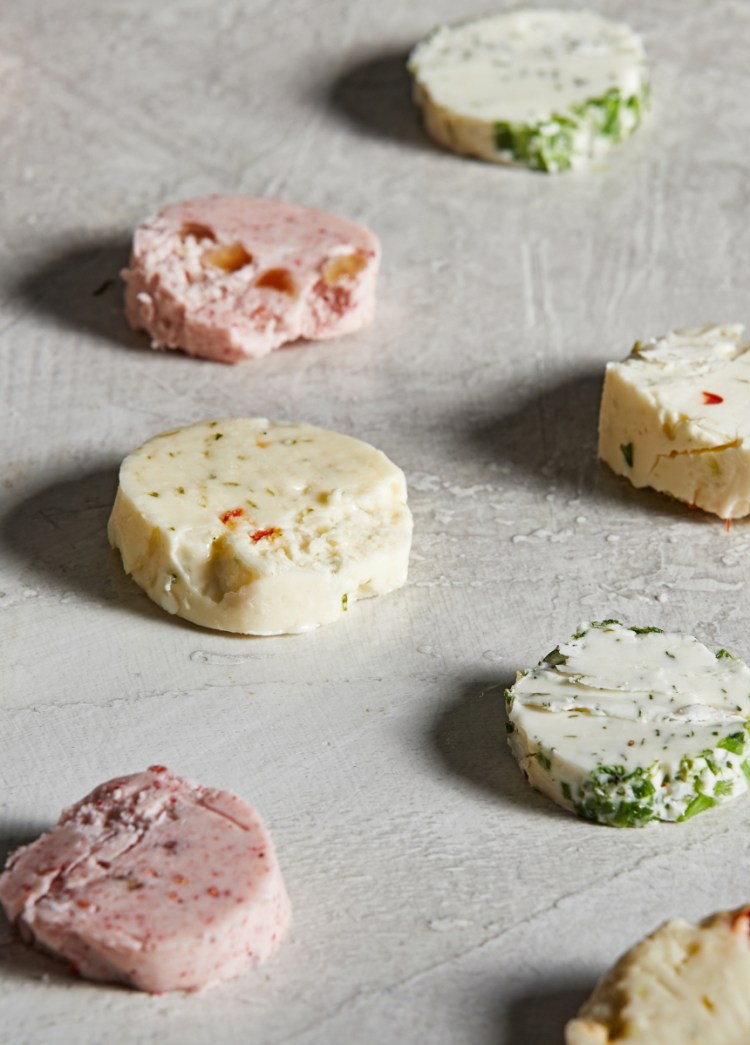You don’t need a culinary degree, or even advanced skills, to make and eat great food. That doesn’t mean we shouldn’t swipe ideas from the pros, especially when they’re simple, versatile and give you back much more than you put in.
Take compound butter. Sounds kind of fancy, but it’s not. It’s flavored butter.
It’s also incredibly easy to make and use. Here’s how:
• Start with the basics. It begins with butter, of course. Chef David Deshaies, a native of France, where compound butter is a staple of the cuisine, likes to leave his butter out overnight to come to room temperature. But if you’re not working with 20 pounds of butter at a time like he is, an hour or so should be sufficient to make the butter pliable and ready for mixing.
Deshaies’s preferred mixing tool is a stand mixer. Use one if you have it, though you can easily pull together a compound butter with a bowl and wooden spoon. A hand mixer works well, too.
In a piece on compound butter for The Washington Post in 2002, Renee Schettler offers a base recipe that starts with 1 stick (8 tablespoons/4 ounces) of butter. First, beat the butter on its own to make it smooth, getting it as light and fluffy as you prefer. Add a pinch of salt and your flavoring ingredients, and combine thoroughly. Adjust the seasoning to taste before scraping the butter onto a sheet of parchment or wax paper, close to one of the long ends. Roll the butter into about a 1-inch diameter cylinder, twist the ends of the paper and refrigerate or freeze. The butter will keep in the fridge for 3 to 5 days and the freezer for several months.
• Flavor to taste. Deshaies recommends keeping your flavoring ingredients to about 30 percent of the final product, tweaking as necessary to accommodate stronger (salty anchovies, spicy pepper) or weaker (more delicate herbs) flavors. “You still want the main flavor to be butter,” the chef says. After that, it’s up to you.
Classic additions, separately or together, are garlic, parsley and shallot. Citrus is a natural, too, whether it’s zest, juice or even something like preserved lemon or lemon confit. The possibilities with dried spices are almost endless. You can lean sweet, too, incorporating freeze-dried fruit (ground to a fine powder), crystallized ginger and spices such as cinnamon and nutmeg.
Avoid turning the butter soupy with excessive amounts of liquid. And keep in mind that you want your butter to be free of large chunks. So finely chop your firmer ingredients. (Deshaies, though, says you can have some fun with texture with such additions as finely chopped peanuts, fried grains of rice and quinoa that can leave behind a crunchy garnish as the butter melts. Ditto finely chopped chives on the outside of an herbed butter.)
• Use far and wide. Compound butters can be incorporated into a dish before cooking or after. You’re probably most familiar with the concept thanks to those pats of butter you might find enticingly melting over a steak at a restaurant. You can do the same with a piece of salmon and vegetables, roasting them with the butter or using the butter as a finishing touch.
With a garlic-and-herb butter already stashed in the fridge, homemade garlic bread is within reach even on a weeknight. Leave store-bought croutons in the dust when you toast cubes of bread with your own flavored butter. Savory compound butters can serve as a quick sauce as well. After you’ve seared or roasted meat, use something acidic (wine, a little vinegar, etc.) to scrape up those tasty browned bits and then whisk in the compound butter for a rich, glossy sauce.
Sweet or spiced butters are wonderful when spread on toast and crowning a stack of pancakes. They’ll make your scones sing, too.
“No one will complain to have a little piece of flavored butter on top of a dish,” Deshaies says.
Send questions/comments to the editors.



Success. Please wait for the page to reload. If the page does not reload within 5 seconds, please refresh the page.
Enter your email and password to access comments.
Hi, to comment on stories you must . This profile is in addition to your subscription and website login.
Already have a commenting profile? .
Invalid username/password.
Please check your email to confirm and complete your registration.
Only subscribers are eligible to post comments. Please subscribe or login first for digital access. Here’s why.
Use the form below to reset your password. When you've submitted your account email, we will send an email with a reset code.